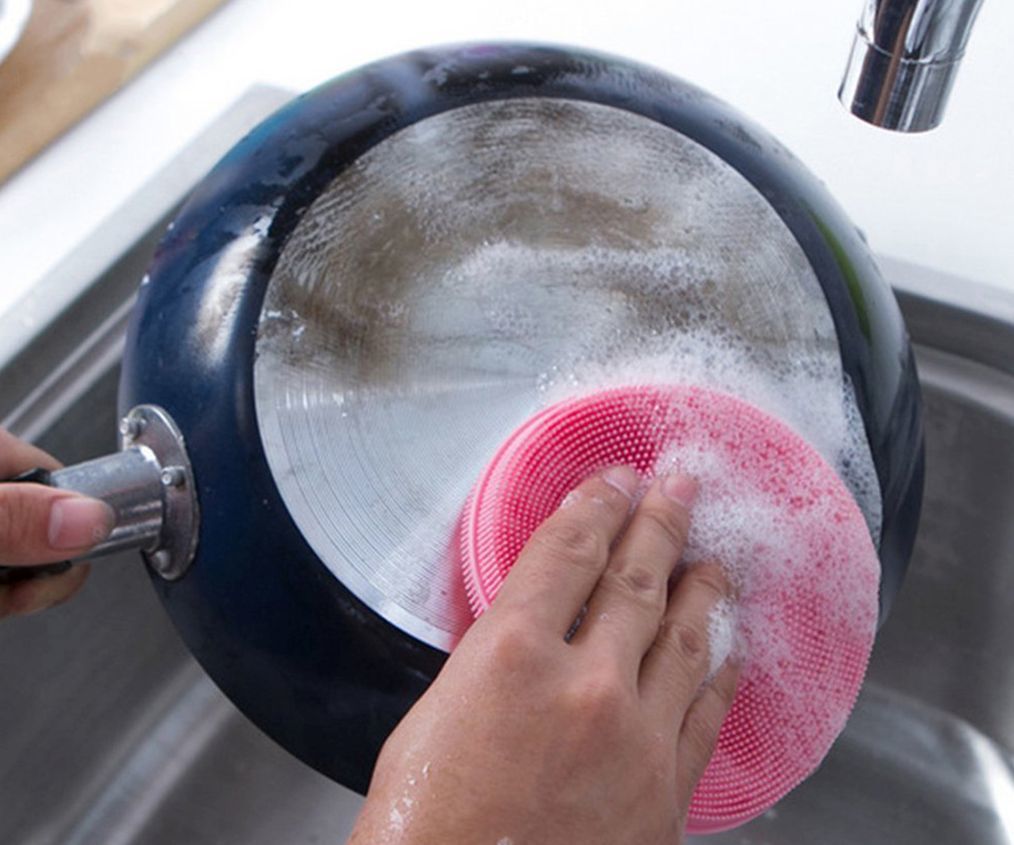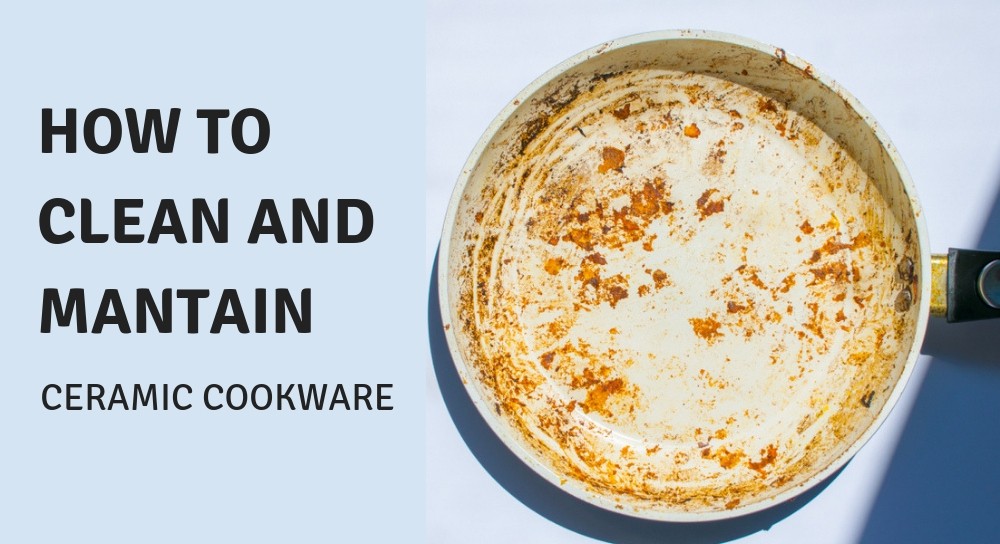With all the negative press about teflon causing cancer, ceramic cookware has become very popular as a non toxic and non stick alternative. However, to get the maximum benefits of your ceramic cookware, it’s important to learn the proper way to clean, and just as importantly, maintain your expensive investment.
The recommended ways to clean ceramic cookware is by washing immediately after you finish cooking by hand, with the help of baking soda or a vinegar solution to help break down tough stains. You can prolong the life of your ceramic cookware through proper storage, adopting the seasoning method, ensuring regular deep cleaning, and cooking on low to medium heat.
Table of Contents
Benefits of Using Ceramic Cookware

There are several key benefits of using ceramic cookware for anyone considering buying one:
- Ceramic cookware is naturally non-stick.
- It can withstand heat of up to 2000 degrees Fahrenheit something which metallic cookware is unable to do.
- It’s naturally hard and durable.
- Can be used on the hob, in the oven, and in the microwave.
- The cooking surface of a ceramic pan or pot heats evenly making it perfect for cooking in.
- Easy to wash and to take care of.
- Sturdy and scratch resistant.
- Ceramic cookware is cadmium free.
- Ceramic cookware is toxin and metal free and safer to cook in.
- Ceramic cookware is available in a wide range of colours and at affordable prices.
Cleaning Ceramic Cookware
There are several easy, quick and wallet friendly ways to keep your ceramic cookware clean.

Most importantly, for best results ceramic cookware should be washed the old school way – by hand – rather than in the dishwasher. Most dishwasher detergents contain harsh chemicals that ruin the surface of ceramic cookware quickly. Second, the pressure of hot water sprayed on pans is hard on the pan’s surface. Third, ceramic cookware becomes scratched or chipped when coming into contact with other dishware. As such, rolling up your sleeves and washing your ceramic cookware by hand will go a along way in protecting your prized cookware.
Wash your Cookware Immediately After Cooking
The best way to ensure ceramic cookware is cleaned properly is to wash up after you finish cooking:
- Make sure that the ceramic cookware cools down properly. This is a good tip to follow for all cookware to minimize the chances of cookware warping. Turn off the stove, and wait until the cookware is cool to the touch.
- Wash ceramic cookware using warm water, mild washing up liquid and a soft sponge or washing pad.
- If the food stains are tough then soak the ceramic cookware in water for 30 minutes before washing.
Ceramic Cookware Manufacturers generally warn against using abrasive sponges and steel wool to clean ceramic cookware. They also advice against the use of metallic spoons or spatula, as they wear down ceramic coating on the cookware. Instead, manufacturers suggest the use of silicone, wooden (particularly bamboo wood) or nylon cooking utensils as the are more gentile to ceramic.
Clean with Baking Soda
Baking Soda is known as a powerful natural cleaning agent in the kitchen. Baking soda is famous for it odor-removing properties; when mixed with vinegar, it is mildly abrasive and can really help remove tough stains. It can help clean, polish and shine almost anything.
Baking soda can also be used to make your well-used ceramic cookware look as good as new.
All you need to clean a big ceramic cookware pot is 2 tablespoons of baking soda.
- Fill your ceramic pot with water, put it on the stove and bring to boil.
- Put in a couple of drops of liquid washing up soap and two tablespoons of baking soda, and allow it to simmer for a couple of minutes.
- With the help of a wooden spatula stir the mixture around until it starts foaming.
- Keep stirring for two minutes more and carefully scrape the bottom and sides and switch off the stove
- Wait for the water to cool down before draining the pot.
- Wash the pot with washing up liquid and warm water.
- Pat the pot dry with a towel or fish cloth.
Clean with Vinegar
Vinegar is a brilliant natural cleaner, it is a solvent, deodorizer, mildly acidic, acts as a disinfectant, cleans wonderfully and is dirt cheap. Did you know that vinegar can clean and shine your ceramic cookware as well? All you need is distilled clear vinegar, baking soda and water for this method.
- Fill your ceramic pot or pan with a quart of water, and add in two teaspoons of baking soda and a quarter cup of distilled vinegar.
- Let the ceramic pot or pan simmer for a little while before the stove is switched off.
- Once the water cools down, drain the water from the cookware.
- Wash the pot or pan with liquid detergent and a soft sponge.
- Dry the ceramic cookware with a soft towel or dishcloth.
Use Hydrogen Peroxide for Burned Stains
We all know the powerful properties of hydrogen peroxide. Hydrogen peroxide can be used to clean windows and glass, kitchen tops, chopping boards, cleaning cloths, refrigerators, microwaves and plastic water bottles. You can also use 3% hydrogen peroxide, available by McKeeson and Leader, to clean large ceramic cookware pots. Hydrogen peroxide produces foam inside the pots when it comes in contact with the burnt areas. This is a relatively simple method where you can remove some hard burn stains if your ceramic cookware.
- Put one ounce of hydrogen peroxide into your ceramic pot.
- Fill the ceramic pot with water, watch carefully to see whether bubbles are created and let it rest for a few minutes. (If the hydrogen peroxide is fresh it bubbles easily, if it‘s been sitting on your shelf for months it won’t.)
- If the stain doesn’t come off, use a soft bristle toothbrush or gauze cloth to clean the stained area gently.
- The pot can be washed with washing up liquid or detergent and a soft sponge.
- Finally, dry the ceramic cookware with a soft towel or dishcloth.
Taking Care of Ceramic Cookware
There are several quick and easy ways to take care of ceramic cookware to ensure it lasts a long time that are listed below.
Store Ceramic Cookware Properly
An important way to prolong the life of the ceramic cookware is by carefully storing it. You can’t leave ceramic cookware lying out in the open as it can get chipped, cracked, or even broken. Ceramic cookware needs to be carefully stored in cupboards or on shelves. One of the most important things to remember is to keep your ceramic frying pans away from other cookware – especially ceramic cookware.
When stacking ceramic frying pans or other ceramic cookware on top of one another, use thick paper napkins to separate them, as ceramic to ceramic contact scratches the ceramic coating. Soft and spongy pan protectors which help avoid ceramic to ceramic contact and scratching can also be used.
Another way to store ceramic cookware is by hanging them on hooks. This will help prevent surface to surface contact with other dishwater and protect your ceramic cookware. Hanging cooking utensils also helps save space into the kitchen.
Avoid Cooking Oil Spray
Cooking-oil sprays in aerosol cans are popular as they are easy to use, but they are a definite no no when it comes to ceramic cookware. Not even the coconut or olive cooking oil sprays should be used.
Cooking-oil sprays have a number of not so natural ingredients and chemicals that can result in a sticky build-ups on cooking surfaces. In addition, many cooking oil sprays contain soy lecithin, which further adds to the sticky buildup. This build up doesn’t wash easily, nor does it burn off, and eventually leads to smoke.
Furthermore, if you use a scrubbing pad to remove the film, the scrubbing leads to peeling, scratching and damage!
Seasoning Ceramic Cookware
Although not an absolute necessity it’s still a good idea to season ceramic cookware two to three times a year. Seasoning ceramic cookware ensures it keeps its non-stick surface from wearing off.
- Start by dabbing a little vegetable oil on to a kitchen towel and wiping the cooking surface of your ceramic cookware with it.
- Make sure you have a thin coating of oil on your ceramic cookware, then put it on the stove for 2-3 minutes at medium heat.
- Take it off the hot stove and allow it to cook before washing it. This simple process will revitalize the non-stick layer on your ceramic cookware.
- The pot can be washed with washing up liquid or detergent and a soft sponge.
- Finally, dry the ceramic cookware with a soft towel or dishcloth.
Regular Deep Cleaning
Another way to keep your ceramic cookware in top-notch order is by deep cleaning it regularly. While the term deep cleaning evokes a picture of you scrubbing for hours on end, it’s actually a quick and easy process.
- Soak ceramic cookware in warm soapy water.
- Next gently rub baking soda on your ceramic pot while it’s wet and leave aside for 15-20 minutes.
- Afterwards gently rub the ceramic cookware with a soft sponge, soft bristle toothbrush or gauze cloth.
Cool Down Ceramic Cookware Properly
Drastic changes in temperature can damage the non-stick coating in your ceramic cookware, this results in the heating and non-stick cooking performance being negatively affected. A hot ceramic pot or pan must not be immersed in cold water. After cooking is completed, place the ceramic pot on a cool burner and allow it to return to room temperature before washing. This will help you improve the lifespan of your ceramic cookware.
Cook on Low to Medium Heat
When using ceramic cookware, it is important to remember that cooking in high intensity heat will cause discoloration and damage. It will damage the non-stick ability of ceramic cookware. Ceramic cookware has great heat conductivity, and the aluminum base distributes heat effectively. High temperatures are not required to cook food quickly. Even water can be boiled or food can be seared at medium temperature because of special heat distribution properties.
Conclusion
We hope that this article shows that there are a number of quick, easy and cheap ways to clean your ceramic cookware effectively. As mentioned above, there are many cleaning agents present in your home which help clean ceramic cookware and keep it looking as good as new.
This article also provides simple and practical suggestions to take care of ceramic cookware. By carrying out regular maintenance on your ceramic cookware, you can ensure that it remains clean, in good order and non-toxic for years to come. This in turn is beneficial for your family’s health and for your wallet!

